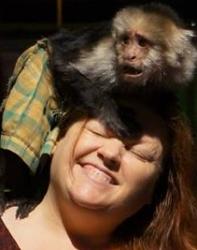My dad used to have a cabin in the San Jacinto mountains above Banning. I always caught a ride with someone because the windy mountain road’s sheer drop offs freaked me out. As we drove out on the 10, I would catch sight of a crumbling roadside attraction. You may have noticed that The LA Beat loves roadside attractions. So I would shout in vain from the back seat, “Bible Land! Bible Laaaaaand!” but no one would ever stop. In 1992, my family decided to celebrate my birthday at the cabin, which really pissed me off. There were some great bands playing in LA that weekend and I didn’t want to be stuck with the tarantulas and rattlesnakes in the desert.
Early on Saturday morning my family insisted we go to the swap meet. As we drove, I got suspicious, “This isn’t the way to Banning….” At last, we pulled up at Bibleland! I was so excited to finally visit sand artist Ted Conibear’s dioramas. In actuality, we were visiting “Bible Land II.”
Mr. Conibear of Detroit was originally a policeman or a carpenter, depending on the source. He discovered his flair for sculpting in sand in 1926 and worked the fair circuit for 30 years as a multimedia sculptor, using sand, ice, and even butter. As he moved west, he left sand sculptures behind in Arizona and California. His specialty was Jesus. He sculpted ten different versions of The Last Supper.
Conibear sculpted the first Bible Land near Temecula in 1957. The sculptures were moved in 1973 to Bible Land II, located in Calimesa. He was constantly rebulding the sculptures as they were damaged by birds, the weather, and worst of all, vandals. According to the LA Times, “In October, 1977, a teen-age boy knocked the heads off six of his statues in Bible Land. After a year and a half of work, Conibear had repaired the statues in time for Easter, 1979–“in tiptop shape”–when, on Palm Sunday, someone destroyed all but two of the 12 heads.”
When I visited, the attraction was made up of a series of cement caves protecting the sculptures from the elements, 3 crosses on a hill, and a cement tomb with a rock that rolled back and forth to unseal the entrance to the tomb. The sand sculptures included Jesus at Gethsemane and The Last Supper. By 1992, Bible Land II was on its last legs, and no one was really watching us as we toured the attraction. So I started hopping over the barriers so my brother could take pictures of me posing with Jesus. My mom got so mad that we were being sacrilegious, she went to wait in the car.
Ted Conibear died two years after our visit, in 1994, leaving behind the religious attraction, Bible Land II. We had heard it was closed down after one of the Southland’s storms ruined the sculptures. Others claimed that Conibear himself ordered that the sculptures be destroyed after his death. Danial Carpenter, who, along with his mother, stayed with Ted Conibear during his final years, and helped to maintain Bible Land, argued that Conibear wanted the sculptures to remain, “I’ve always wanted the world to know that this man had dreams of keeping his work alive, he taught me how to make the statues using only sand, water, and a spoon!!!”
In 2011, there was a comment left on a Pasadena Adjacent story:
“I am Don Conibear, son of Ted Conibear the creator of Bibleland. There is a lot of mis-information in the above comments. First, I am not an athiest. At the time of Dad’s passing his work had grossly deteriorated due to wind erosion, insects and the fact that dad had not been able to properly maintain the statues for several years. We, the family agonized over the disposition of Dad’s work. Efforts were made to organize an enity [sic] to maintain and preserve his Bibleland. There was interest from several sources, but no funds. After close to a year the decision was made to take down his work. By this time things had deteriorated to the point that we felt that if it were to be restored. so much needed to be done that it would no longer be Dad’s work. This was a very difficult decision, knowing that it would be gone for ever…:”
Chapman Henry, “The Bible is his Beat,” The Family Weekly January 7, 1962
Hicks, Sam. “The Sand Man” Desert: The Magazine of the West. December, 1964.
Morrison, Pat “Religious Statues Vandalized : Not a Grain of Doubt–Sand Sculptor to Rebuild.” The LA Times. October 11, 1986.
Roadside America “Bible Land Sand Sculptures ”







Thank you for creating this wonderful narrative concerning Bible Land — it has resurrected many fond memories from my past. I was raised in La Mesa (of East San Diego County). My father, who was a lifelong Bible student, took our family to Bible Land in Temecula in the late 1960s and early 1970s — he was enamored with this roadside attraction for not only its exquisite sculptures but also for the way it gave glory to Jesus. A story which he shared with our family on more than one occasion: he told us that Ted Conibear had mentioned to him that he used real people as models to fashion the faces of the sculpted figures. Apparently, by coincidence, Ted happened upon the man he had used some years earlier as the model for Jesus and found that his appearance had dramatically changed (for the worse), so he proceeded to use him as the model for Judas Iscariot.
That made me laugh out loud!
My parents stopped there many times when I was young. Being there gave me a special feeling of peace and being loved by Jesus.